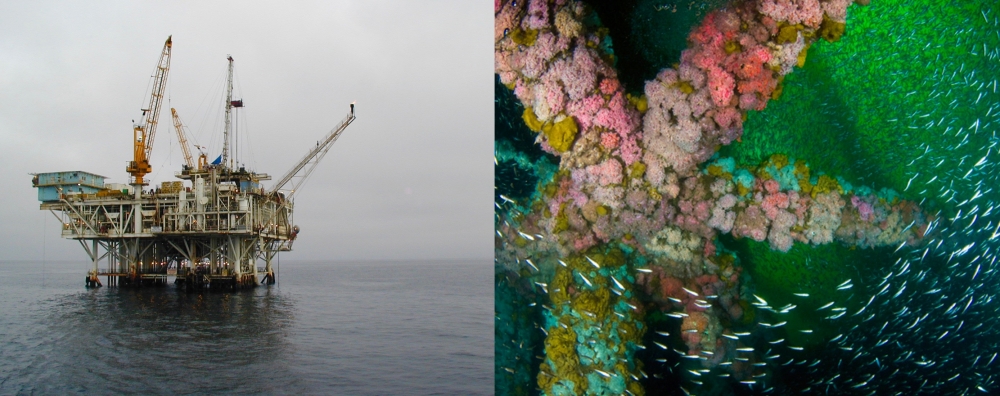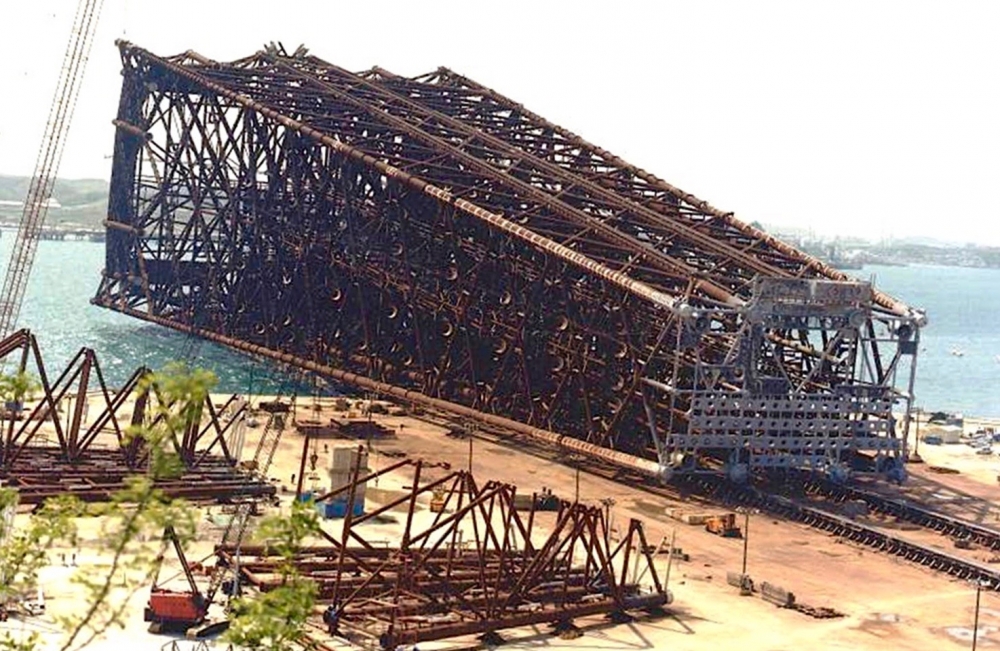
Rigs to Reefs


Offshore oil platforms have an immense presence, physically, financially and environmentally. Some 6,000 rigs pump petroleum and natural gas worldwide. But as they extract hydrocarbons from deep beneath the sea, these structures undergo a transformation invisible from above the waves. The ocean claims the platforms’ enormous substructures and converts them into vertical reefs, home to millions of individual plants and animals.
While decommissioning a platform is a tall order, a growing number have found new purpose as human-made reefs. Now, researchers at UC Santa Barbara have published a comprehensive study of the history, ecology and pragmatics of rigs-to-reefs efforts in the journal Ocean and Coastal Management.
In addition to assembling information from across a large corpus of work, the scientists hope the study will help inform California residents and policymakers as they decide what to do with platforms slated for retirement off its coast.
“California citizens are going to have to make decisions about the continued existence of vast marine life under the platforms, and they should be informed decisions,” said Ann Scarborough Bull, a researcher at UC Santa Barbara’s Marine Science Institute (MSI) and the paper’s lead author. This issue will return time and again across the world as platforms age and existing oil fields wind down production.
Scarborough Bull served for nearly 30 years as an environmental analyst and researcher in the Department of the Interior’s Minerals Management Service, now the Bureau of Ocean Energy Management. She joined UC Santa Barbara after retiring as the agency’s chief of environmental sciences for the West Coast.
In 2017, organizers of an industry summit on oil well decommissioning invited Scarborough Bull to speak on the science behind transitioning platforms into permanent reefs. At the time, she found that literature on the topic was rudimentary and fragmented. After joining the university, Bull decided to compile the scattered information into a seminal article, to which she added the results of her own extensive research.
“As far as we know, the paper is the first of its kind,” said research biologist Milton Love, also at MSI, who co-authored the study with Scarborough Bull.
An Ecological Oddity
There’s little doubt that the petroleum coming from these platforms has a negative impact on the environment. And the possibility for destructive oil spills always exists when oil production and water mix. The risks may be minimized if the work is done properly, but the consequences of an accident are still quite high. “Oil spills are terrible events,” said Scarborough Bull, “and if you put in a platform and you drill and produce oil, you always have some level of risk.”

Giant sea stars feed on mussels growing on the leg of an oil platform off the coast of California.
Photo Credit: ANN SCARBOROUGH BULL
However, these hulking structures, rising hundreds of feet from the ocean floor, provide a unique habitat. The complex shape of the rig’s support creates a 3-dimensional reef for animals to colonize and live near. And the rig’s open construction allows currents to pass through, bringing nutrients.
“We say, ‘oh, we’ll turn these platforms into reefs,’” said Love, “but as far as the marine life is concerned, they already are reefs.”
In 2014, Scarborough Bull and Love collaborated with colleagues at Occidental College to assess the biological productivity of oil rigs off the coast of California. Using standard models and metrics, the team compared the platforms to all the other habitats they could find information on. The results of the study were staggering. “Platforms off of California, as far as fish were concerned, were the most productive habitats in the world,” recalled Love.
“More productive than coral reefs, more productive than Chesapeake Bay,” he continued. “Now does that mean that they are truly the most productive? Well, we don’t know. But based on the world literature at that time, they were the most productive habitat.”
Perspectives on rigs-to-reefs efforts vary across country and ideology. Those with a preservationist mindset want to restore the site to its original condition. The European Union currently follows this policy and all decommissioned platforms in the EU must be removed completely. Meanwhile the practice of reefing old platforms is now routine in the Gulf of Mexico. As of 2016, over 11 percent of decommissioned platforms in the U.S. portion of the gulf were transitioned into permanent reefs, according to Scarborough Bull. The region currently has over 500 rig-reefs, not including those that are still part of active platforms.
The oil companies stand to benefit from reefing old platforms, but some conservationists, fishermen and state governments have also found reason to support this trend. “In the Gulf of Mexico, when you go fishing, you motor up to a platform and tie directly to it,” said Scarborough Bull, who spent 12 years in the region. “There’s a different societal thinking about the use and usefulness of parts of platforms that you don’t have in California.”
A Daunting Task
Decommissioning a platform typically involves its complete removal from the seafloor, then hauling it away for disposal or scrap. It’s a pricy proposition. The most recent estimate for removing all platforms off of the California coast totals $8 billion, Scarborough Bull said. Modifying the platforms to serve as permanent reefs cuts these costs significantly, especially those associated with hauling, cleaning and disposing of the support structure on shore, which will have thousands of tons of sea-life clinging to it by the time it reaches retirement.

A platform support structure dwarfs the construction vehicles tasked with building it.
Photo Credit: ANN SCARBOROUGH BULL
To convert the lower portion of the platform into a permanent reef, the structure must be free of any hydrocarbons or other hazardous materials described in any federal, state or local law, ordinance, rule, regulation, order, decree or requirement. Yet this is still a far cheaper venture than total removal. And the savings don’t merely benefit the oil company, which foots 100 percent of the decommissioning cost. Coastal states that have rigs-to-reefs laws require that the company share with the state a portion of the money it will save if a platform is reefed rather than removed; often 50 percent of the cost savings, explained Scarborough Bull.
What’s more, the reef and nearby surrounding waters belong to the state and fall under its jurisdiction, even if the platform had been in federal water before it was retired. Twenty-three platforms slated for decommission off the California coast are in federal waters and one, Platform Holly, is in state waters, but deep enough to be considered for reefing.
The state assumes title and responsibility for the site once the reef is established, which includes taking the proper steps to prevent the reef from becoming a shipping hazard. This involves recording the location on charts and installing buoys to warn of any navigational hazards, depending on how close the reef comes to the surface. The study discusses these practical considerations at length, important factors when deciding how to retire old platforms.
“Decisions are going to have to be made about more and more of these structures,” said Love. “We want everyone to have the same facts as they go into the process so decisions can be made on a rational basis.”
More research stories from the Santa Barbara Channel can be found in The Current's featured compilation, Channel for Discovery.



